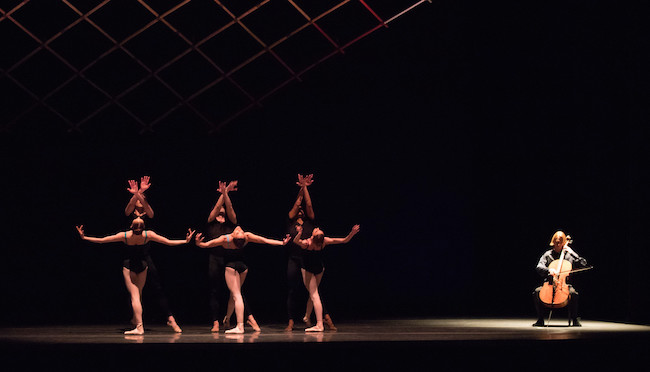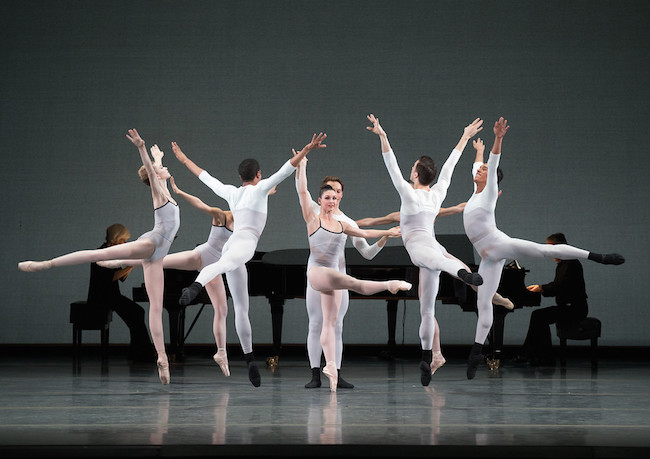Dance Review: Boston Ballet – Revisiting
What a treat to see choreographers of different generations concentrating on ballet itself and asking the audience to appreciate what ballet can do.
“Parts in Suite” Boston Ballet: Bach Cello Suites (Elo), In Creases (Peck) and Pas/Parts 2018 (Forsythe). At Boston Opera House, Boston, MA, through April 8. April. *In alternation with John Cranko’s Romeo and Juliet.

Boston Ballet in Jorma Elo’s “Bach Cello Suites.” Photo: Rosalie O’Connor. Courtesy of Boston Ballet.
By Marcia B. Siegel
All three of the ballets in current repertory at Boston Ballet are reworkings of “old” ballets, and at the same time they’re all “new” to the audience. Dance hasn’t got repertory in the sense that music does, as a permanent reservoir of works that can be drawn on at will. Most dance companies, like Boston Ballet, keep a work around a few weeks, then retire it for an indefinite amount of time. When a choreographer revisits an old work he or she often makes small adjustments to suit the available dancers, or creates improvements to the existing scheme. The audience can’t learn a dance the way we can a piece of music. Even the staples of the dance repertory incur microscopic changes with each new cast of dancers. It’s this very instability that makes watching dancing a challenge and a rare pleasure.
The program, dubbed “Parts in Suite,” gave the Ballet orchestra the night off; two of the three musical selections were played live onstage and one was recorded. The sounds ranged from Bach’s pristine baroque cello to Philip Glass’s implacable minimalism and Thom Willems’s synthesized menagerie. All three ballets were rooted in rigorous classical dance and its conventions. What a treat to see choreographers of different generations concentrating on ballet itself and asking the audience to appreciate what ballet can do.
What struck me about the first version of Jorma Elo’s Bach Cello Suites (I reviewed it in 2015 for The Arts Fuse, Cascades) is that the choreographer appeared in the midst of the plotless piece and began “choreographing” two of the dancers. That little drama is gone now, and I can’t tell what other changes Elo has made to the work. It’s still a compendium of solo cello pieces by J. S. Bach (played onstage by guest artist Sergey Antonov), and still very long.
Unlike all the other Elo pieces I’ve seen, Bach Cello Suites features a classical ballet vocabulary, with eccentricities. The steps can be demanding but Elo presents the ten dancers as a kind of community, sometimes a wayward one. They keep disrupting what ought to be given rules for a formal ballet: group designs, unison movement, fixed partners, beginnings and endings coordinated with the musical selections. The one scenic element, a massive wooden grid that hangs overhead on a diagonal and occasionally tilts, was designed by artistic director Mikko Nissinen and dramatically lit by John Cuff.
When Justin Peck’s In Creases begins, we’re in a different though familiar place. Two grand pianos stretch throat-to-throat across the back of the stage. (The pianists were Freda Locker and Alex Foaksman.) Glass’s “Four Movements for Two Pianos” (Parts One and Three) begins with a crash, and the rest of this 14-minute-piece continues with the composer’s familiar repetitive chordal textures, some severe, some calmer. As Peck’s eight dancers leapt across the space and strutted in formations, I imagined the choreographer might have been either celebrating the music’s grandiosity or making fun of it.
In Creases was one of Justin Peck’s first ballets, made in 2012 for the New York City Ballet. It was Boston’s first glimpse of his work, and you could see right away how he galvanizes his dancers, gives them permission to loosen up their weight and have fun. The audience Friday night was delighted with it.
William Forsythe holds a multi-year choreographic residency with Boston Ballet, and so far he’s been setting his older works on the company. Pas/Parts 2018 was first made in 1999, midway in his varied career, and he reset it two years ago for San Francisco Ballet. The Boston edition is different again. As Forsythe describes it, in interviews quoted from a program note by San Francisco’s Cheryl A. Ossola, it’s about shifting structures. But he talks in very dense, sometimes elliptical terms and few palpable images. At the revival Friday, Thom Willems’s music made a more visceral impression on me than the dancing itself.

Boston Ballet in Justin Peck’s “In Creases.” Photo: Rosalie O’Connor. Courtesy of Boston Ballet.
Willems scored most of the Forsythe ballets I’ve seen, and — knowing the choreographer is a deep-dyed subversive — I wasn’t surprised that there was no conventional music in the score. We heard barely identifiable instrumental and electronic sounds blended with singing and speaking voices. There were muffled drums and gongs, submerged Latin rhythms, big animals growling in their sleep, clattering pots in a dishpan, and a lot more things you never heard or imagined. Sometimes it sounded like extruded sound effects. I liked it.
The dance had 20 sections, not necessarily separated as such by the dancers, in no particular sequence I could determine. They sorted themselves out in solos, duos, trios, a men’s group backing up a female (Lauren Herfindahl), an ensemble of four women and three men. The whole thing progressed in such small, discrete increments I couldn’t take in all the ways it worked. Slowed down, I could have appreciated the solos, the ingenious trios, the duets, but possibly that very fragmentation was what Forsythe intended.
Finally the dancers began to assemble, in formal groups that didn’t solidify long enough for the audience to see what was happening, After an indeterminate period of time, fourteen of them had collected in a symmetrical pattern, facing the audience, with Misa Kuranaga at the center. The lights changed importantly. The section was listed in the program as Number 20, and custom requires the entire cast to gather and be appreciated at the end of an important ballet. But I realized it wasn’t the typical finale either, because I didn’t see the names of the four other dancers who had whisked in and out during the dance listed in the program for the last number.
William Forsythe can seem like a chronic denier, but he still seems to believe that to make any progress, you dismiss the precedents. With Pas/Parts 2018 he surprised us again. Of course, I wanted to see — and hear — this dance again.
Internationally known writer, lecturer, and teacher Marcia B. Siegel covered dance for 16 years at The Boston Phoenix. She is a contributing editor for The Hudson Review. The fourth collection of Siegel’s reviews and essays, Mirrors and Scrims—The Life and Afterlife of Ballet, won the 2010 Selma Jeanne Cohen prize from the American Society for Aesthetics. Her other books include studies of Twyla Tharp, Doris Humphrey, and American choreography. From 1983 to 1996, Siegel was a member of the resident faculty of the Department of Performance Studies, Tisch School of the Arts, New York University.
Tagged: Boston-Ballet, Jorma Elo, Justin Peck, Marcia B. Siegel, Parts in Suite
